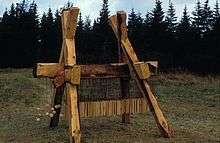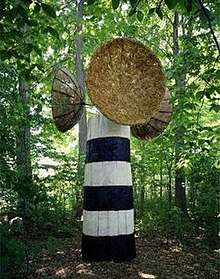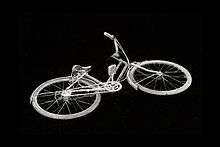Will Gill
| Will Gill | |
|---|---|
| Born |
Christopher William Gill July 5, 1968 Ottawa, Ontario, Canada |
| Nationality | Canadian |
| Education | Mount Allison University |
| Known for | Sculpture, Painting, Photography, Video art, Performance art |
| Website | williamgill.ca |
Christopher William "Will" Gill, BFA (born July 5, 1968) is a Canadian contemporary artist known for his wide-ranging works in sculpture, painting, photography and video. Born and raised in Ottawa, Ontario, Canada, he received his Bachelor of Fine Arts in 1991 from Mount Allison University, where he studied sculpture and printmaking. In 1997 he moved to St. John's, Newfoundland. "Some of Gill's notable works have drawn upon the Newfoundland landscape. In the 2009 performance Cape Spear, he tossed fibreglass-encased glow sticks off of the easternmost point of North America using a catapult."[1] "The 2009 installation Bareneed is a replica of a cast-iron bathtub that Gill saw on the bottom of the ocean floor while sea-kayaking near the titular coastal community (the artist himself has noted that the St. John's setting has been key to his art production)."[2] Gill was longlisted for the Sobey Art Award in 2004[3] and 2006.[4] In March 2013, Gill was selected from a group of 31 artists to create an indoor public art installation in the lobby of a new office building in St. John's, set to open in the spring of 2014 - the first private juried art commission in the province awarded to a local artist.[5] From June to November 2013 he exhibited along with artist Peter Wilkins as part of an official Collateral Project at the 2013 Venice Biennale.[6]
Career profile

"Like many university students, Gill sought out a new setting for an opportunity to grow as an art student. 'I studied sculpture at Mount Allison University because I had grown up in Ottawa and needed to be in a new environment,' he says. 'I had no idea what to expect from a BFA program, but I knew that being creative excited me. I ended up majoring in sculpture and printmaking because they were both mediums that relied heavily on materials and processes: often it was not about what you ended up with, but how you got there that mattered most. I liked troubleshooting and figuring out how things could be put together. The qualities of materials fascinated me.'"[7]

After an inspirational journey around the Avalon Peninsula in 1996, Will Gill decided to move to St. John's, Newfoundland, where he was soon offered an opportunity to work as an apprentice at the bronze casting foundry located at the Boreal Sculpture Park and Garden Foundry, run by sculptor Luben Boykov and environmentalist John Evans. "'There was something about the people and place when I came here that seemed just perfect for the way I am, the way I like to live,' he says. 'The temperament of the people, the generosity and so on. And it was that that made me think right away: this is it. I fell in love right away.'"[8] He has lived in St. John's ever since.
Because of his apprenticeship, and later his work as a technician at the foundry, Gill's early sculptural works often incorporated elements of cast bronze, along with wood and other natural materials. "It is informed by contrasts and juxtapositions, the most obvious being the dichotomy between nature and culture, but he also plays with that of the traumatic and the monotonous, the exuberant and the upsetting and, of course, the man-made and the natural."[9] Line of Green Stars (1998) exemplifies these characteristics.
"Interestingly, Gill never cuts a tree for his sculptures; instead, he recycles and reclaims fallen trees and dead wood that he finds in the forest or salvages from building demolition sites. An example of such recycling is the wood coming from the infamous Mount Cashel orphanage ground. The main building was levelled four years ago, many years after the scandal of sexual and physical child-abuses by Christian Brothers. Trees were also cut down to put up a supermarket. The maple the artist recovered from the site is found in his work titled Workhorse (1998), permanently installed at the Boreal Sculpture Park in St. John's. Hanging from the maple beam are some 500 rectangular pieces of birch on bronze rods. While the birch and bronze elements reflect each other by their similarity in size and shape, these two parts of the sculpture present opposing qualities. The marks left by the chainsaw stand as witness of the artist's intentions while conferring roughness, solidity, and strength to the piece. In contrast, the mirror image hung on bronze rods that is animated when the wind blows is delicate and lyrical in feeling."[9]

Gill has a particular fascination with large scale works of art. In 2001, Gill attended the prestigious Vermont Studio Center where he was an artist-in-residence in sculpture. While there he created Automated Butterfly Catching Unit (2001), a large sculptural work, now in the collection of the Province of Newfoundland and Labrador, previously exhibited at The Rooms provincial gallery. The site-specific work Lighthouse (2003), constructed in the woods at the MacLaren Art Centre in Barrie, Ontario, is 18 feet in height. "In this work Gill created a protection device usually situated on the physical boundaries of water and land. Traditionally a lighthouse's purpose is to warn of nature's destructive force - to protect people from danger; Gill's lighthouse is intended to do the opposite. His creation can be perceived as a warning sign to protect the old trees, a natural heritage, against industrialization, as well as suggesting a historical link connecting Simcoe County's past, its present, and its future".[10] Cloud (2006), a whimsical sculptural work also 18 feet tall, was named as one of the 25 greatest works of art ever made in Newfoundland and Labrador.[11]


Gill's paintings, which he creates in small and sometimes very large scale sizes in his private studio, have been described as "simplistic and layered...invitingly crafted and coloured."[12] "Cemetery Park (2008) is as frisky and playful as Gum Machine (2008) (both acrylic and collage on panel), with the tombstones and crosses of the former as animated and full of bouncy colours as the latter's gumballs. Others pinwheel and spring with clouds of vanilla and spokes of red and orange. Their energy vaults from the walls."[12] His newer painted works, such as Smokestack/Flower (2010) and Black Water (2012) continue this theme. Gill's paintings have been exhibited locally, as well as nationally and internationally.[13]
In recent years, Gill has expanded his artistic scope by adding performance, video, and photography to his repertoire. "For his 2009 work Cape Spear, he used a massive catapult to launch glowing orbs off the tip of North America's easternmost point (Cape Spear) and into the ocean. The work was documented with photo and video. He's also often inspired by his adopted home of Newfoundland: his 2009 installation Bareneed is a replica of an old-fashioned bathtub that Gill saw on the ocean floor while sea-kayaking in the coastal community of Bareneed."[7] Firefly #1 (2011) is a still image taken from Gill's video work Firefly (2011), commissioned for the Electric Speed project[14] which commemorated the anniversary of the birth of Marshall McLuhan. The concept for the video "came about through a kind of meditation on the nature of contemporary communication in Newfoundland.... and the images of light moving through the picture frame were meant to convey signals frantically going back and forth as word spread about an accident. Cell phone signals perhaps".[15]
In his haunting installation, High Water, at Toronto's Nuit Blanche 2012, "ghostly objects float on the surface of a small pond in the shadow of Roy Thompson Hall, like lost possessions after a disaster - a baby onesie, a bicycle, a gas canister".[16] Gill then captured the eerie scene in series of photographs. Bicycle/Leaf (2013) is one such image.
In 2013, Peter Wilkins and Will Gill were officially selected by curator Massimiliano Gioni to exhibit as a collateral project with the 55th Venice Biennale. Organised by the Terra Nova Art Foundation, the exhibition was titled About Turn: Newfoundland in Venice, Will Gill & Peter Wilkins.[17][18] The exhibition was co-curated by Mireille Eagan and Bruce Johnson. It was on display at Galleria Ca'Rezzonico until November 24, 2013.[19]
In 2014, 351 Water Street, a new office tower in downtown St. John's, Newfoundland, was opened.[20] It features Gill's Black Island Punt (2014) on permanent display in the lobby. Gill's proposal for a full-sized stained-glass filled traditional wooden fishing vessel was one of 31 submissions from qualified artists and artistic groups from all around the world, and was the first private juried art commission in the province, valued at $100,000, awarded to a local artist.[21] Gill worked with master boatbuilder Jerome Canning on the piece, which was inspired by the original Black Island Punt crafted by fisherman John Dorey in Notre Dame Bay in the 1950s.[22] "The goal was to create an effect that would be at once magical, wondrous and filled with life" Gill says. "I also like the idea of trying to show the inner spirit or life force in things. So several years ago I began to work with light in my work, whether it was emanating out from sculpture, or being reflected off its surface." "I have always liked the structure of things, their internal armature or skeleton. Is there anything more beautiful than the structure of a boat?" he says.[22]
Gill's artwork is also newly featured in the Newfoundland Room at Canada House, Canada's high commission in London, England, which was officially reopened in early 2015 after an extensive renovation.[23] As part of the makeover Canada House ran a competition for artwork - largely to be translated into area rugs for the palatial reception rooms.[24] Gill's acrylic painting Ocean was recreated as a floor covering. "I actually work on most of my paintings with the canvas directly on the floor, so in this case the image returns to the place it originated." He says the palette of blues against the muted background speaks to the spirit of his home province. "It's an expression of movement, vigour and life that is so much a part of everyday existence in Newfoundland - could be wind patterns, could be an iceberg slowly tracing a course on the ocean. When icebergs float by the narrows of the St John's harbour in spring, the sea becomes an ever-changing landscape, an active landscape."[24]
And while his success grows nationally and internationally, "overall, Gill appreciates the freedoms afforded by living in a collaborative, community-focused scene like that of St. John's. In addition to working as an artist and having his own studio, he also works as a gallery installation technician at The Rooms, Newfoundland and Labrador's provincial museum."[7]
"Gill also notes that success in the art world - whether you're in a city large or small - is more a matter of character than of big-name credentials. 'I found that perseverance was the most important thing after graduating. Finding ways to keep making work, and to be around other creative people, is vital as an artist.'" [7]
As well as producing works of art, Gill has also been a member of the jury committee for the St John's Municipal Art Procurement Program, the Newfoundland and Labrador Arts and Letters Awards, as well as the Canada Council for the Arts Project Grants Program.
His work is represented in private and public collections in Canada and internationally.
References
- ↑ Moore, Lisa. At the Edge of the Universe: Will Gill's Art of Place. Canadian Art Magazine, Fall 2010, pp.124-129
- ↑ Canadian Art Magazine Online. Artist Profile: Will Gill
- ↑ Sobey Art Foundation press release. Sobey Art Foundation Announces Regional Short Lists for 2004 Sobey Art Award. September 18, 2003
- ↑ Sobey Art Foundation press release. Sobey Art Award semi-finalists announced for 2006. November 9, 2005
- ↑ East Port Properties press release. East Port Properties Awards Blank Canvas: 351 Indoor Art Commission. March 25, 2013
- ↑ Terra Nova Art Foundation press release. Newfoundland & Labrador takes the World Stage: Province's artists to exhibit at the Venice Biennale. February 19, 2013
- 1 2 3 4 Canadian Art Magazine Online. Will Gill, Multidisciplinary Artist. February 2, 2012
- ↑ Keating, David. Off the Cape. The Scope, September 10, 2009, p.19
- 1 2 Longchamps, Denis. Juxtaposing the artworks of William Gill. Espace Sculpture Magazine #61, Fall 2002, pp.40-4
- ↑ Longchamps, Denis. Shore/Lines: Responding to place. Espace Sculpture Magazine #65, Fall 2003, pp.38-39
- ↑ Power, Craig Francis. The 25 Greatest Works of Art Ever Made in Newfoundland and Labrador. The Scope, August 13, 2009
- 1 2 Sullivan, Joan. One gallery, two differing visions. The Telegram, December 12, 2008
- ↑ Will Gill: Exhibitions
- ↑ Electric Speed website
- ↑ Waddell, Justin. Will Gill - Interview. Vague Terrain, January 12, 2012
- ↑ Leong, Melissa. Plan of Attack: Nuit Blanche’s nocturnal art race. National Post, September 28, 2012
- ↑ Goodden, Sky. Two More Artists Added to Canada’s Official Representation at 2013 Venice Biennale. ARTINFO, February 21, 2013
- ↑ Sandals, Leah. Newfoundland Artists Cruise Onto Venice’s Grand Canal. Canadian Art Magazine Online, May 29, 2013
- ↑ Terra Nova Art Foundation
- ↑ Robinson, Andrew. 351 officially opens. The Telegraph Journal, June 26, 2014
- ↑ Local artist Will Gill chosen to create 351 art installation. The Telegram, March 25, 2013
- 1 2 Spotlight on Artist Will Gill and 351 Water Street. Business & Arts NL, September 1, 2015
- ↑ Canada House in London reopened today by Queen Elizabeth. CBC News, Feb 19, 2015
- 1 2 Himelfarb, Ellen. The art of decorating Canada House. The Globe and Mail, February 22, 2015